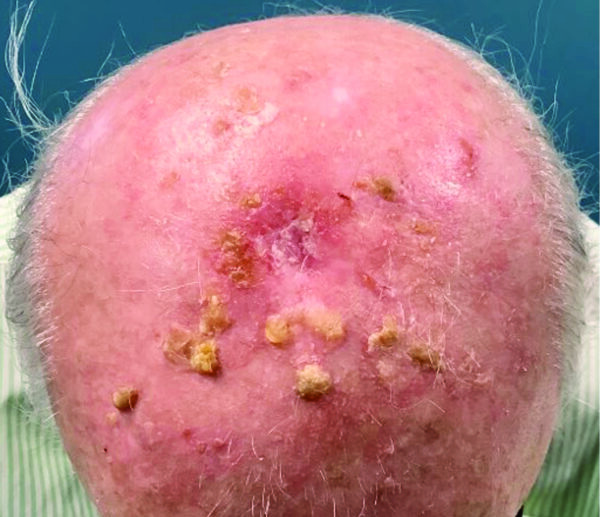Photo credit: Kirbyphoto/iStock/Getty Images Plus
Men and women with thinning hair and bald spots are more vulnerable to sun exposure, which can lead to precancers and skin cancers. The earlier you start protecting your scalp from the sun, the better. Here’s why.
By Joanna Dong, MD, and C. William Hanke, MD, MPH
A bald scalp often reveals its history of years of sun exposure. With minimal or no hair to shield it from damaging ultraviolet (UV) rays, the skin on the scalp can develop redness, flaky patches and a rough texture (some say like sandpaper). These may signal precancerous spots or areas called actinic keratoses (or AKs). Some AKs can be so extensive, the precancerous condition affects nearly the entire surface area of the exposed scalp. About 5 to 10 percent of AKs turn into skin cancers, and some of those become large and aggressive.
Men, you likely know the stats: About 85 percent of you will have significantly thinning hair by the age of 50, according to the American Hair Loss Association — and two-thirds of you by the time you’re just 35. Women aren’t exempt, either, representing 40 percent of those who suffer hair loss.
Q: How can I tell if I have precancerous spots on my scalp?
A: You may develop a change in the skin’s texture, which can range from a dry feeling to numerous rough growths. You may have a tendency to pick at these rough growths, which are often elevated off the skin and may itch, cause pain or bleed easily. These are likely precancers. If not treated, AKs can become squamous cell carcinoma (SCC), the most common type of skin cancer to appear on the scalp. Sometimes these cancers grow outward from the scalp like a tiny horn. (Basal cell carcinoma, or BCC, and melanoma can also develop on the scalp.) If you suspect you have precancers or skin cancer on your scalp, or notice anything new, changing or unusual, you should visit your dermatologist for a skin check.

Vulnerable on Top: This 71-year-old man, one of Dr. Hanke’s patients, has multiple actinic keratoses (AKs) on his scalp. “Thick AKs can often progress to invasive squamous cell carcinoma,” Dr. Hanke says. “We recommend prompt treatment to prevent it from progressing.”
[Photo credit for scalp lesions shot: C. William Hanke, MD]
Q: Is sunscreen on the scalp enough to prevent skin cancer?
A: Skin cancer of the scalp is more common in men than women, due to hereditary baldness in men. While sunscreen with sun protection factor (SPF) 30 provides 97 percent protection against UV rays from the sun, you need to apply a generous amount for full coverage of the scalp, and most people apply less than the required amount. For sunscreen to remain most effective, you also need to reapply it every two hours, which is not that realistic in real life. Sunscreen with SPF 50 (which filters 98 percent of UV radiation) could provide more adequate protection, but you’d still need to reapply. Therefore, hats are often the best way to protect against sun damage on the scalp. As long as you wear it, the protection is constant.
Q: I wear my favorite baseball cap when I go out in the sun. That’ll protect against sun damage, right?
A: In short, no. We understand that you may prefer the style (and your team!), but baseball caps don’t provide sufficient protection against sun damage. They only cover about a quarter of your head, leaving areas like the ears, back of the neck and the chest exposed. Further, if the hat has mesh fabric, it offers minimal protection for the scalp. The ideal hat for sun protection has a wide brim with a tightly woven fabric that prevents light rays from getting through. Clothing and hats often have a UPF (ultraviolet protection factor) rating, indicating the amount of sun protection the hat provides. Look for hats labeled UPF 50+, which provides similar protection levels to SPF 50 in sunscreen.
Baseball caps don’t provide sufficient protection against sun damage. They only cover about a quarter of your head, leaving your ears, neck and chest exposed.
Q: I have been diagnosed with precancers and skin cancers on the scalp. Is the damage already done? Is there anything I can do now?
A: Half of patients with a first-time diagnosis of BCC (the most common overall type of skin cancer) will develop a second one within the next five years. This type of skin damage occurs after decades of sun exposure. However, you can decrease your risk of a future skin cancer even when you already have precancers or skin cancers. Treatments include photodynamic therapy (“blue” or “red” light therapy), topical chemotherapy treatments, oral nicotinamide (vitamin B3) supplementation and oral retinoids. The earlier you start and the longer you maintain these treatments, the more benefit you will receive. The texture of your skin will improve as the AKs resolve. However, these treatments are not effective in treating existing skin cancers. Invasive skin cancer requires more extensive treatment such as curettage (a “scrape and burn”), surgical excision or, in certain cases, Mohs surgery. In some advanced cases of skin cancer, chemotherapy, immunotherapy or radiation therapy may be necessary.
Q: I’m a woman with a full head of hair. Am I at risk for skin cancer?
A: In our clinic, we often see women develop skin cancer on their scalp, even with a full head of hair. These patients often have a history of significant sun exposure such as regular tanning bed use or growing up on a farm. Natural redheads are also at increased risk. Skin cancer on the scalp in females is not well studied, but we can hypothesize that sun exposure over a long period of time can cause skin cancer growth, even with hair as a protective factor. Therefore, women should be aware of this risk and take sun-protective measures such as wearing a hat. Note any changes in texture or appearance of the skin on your scalp. It is harder for women to see changes on their scalp, so ask a spouse, family member or hairdresser to help. Make sure your dermatologist checks your scalp during each routine skin exam, too.
Joanna Dong, MD, is a dermatologist who is completing a fellowship in Mohs surgery under the mentorship of C. William Hanke, MD, at the Laser and Skin Surgery Center of Indiana and Ascension St. Vincent Hospital, Indianapolis.

C. William Hanke, MD, MPH, is a Mohs surgeon at the Laser and Skin Surgery Center of Indiana. A senior vice president of The Skin Cancer Foundation and a member of its Amonette Circle, he has also served as president of 13 professional societies.




